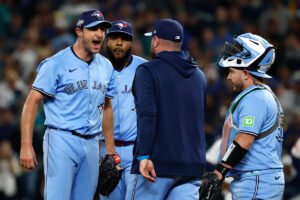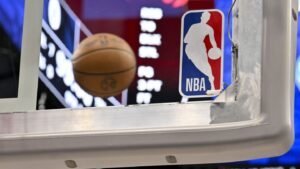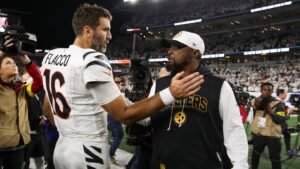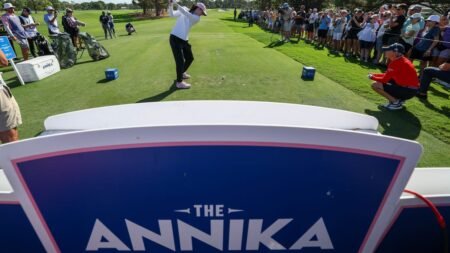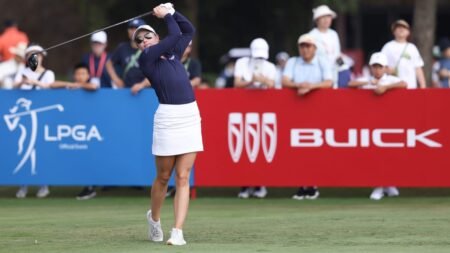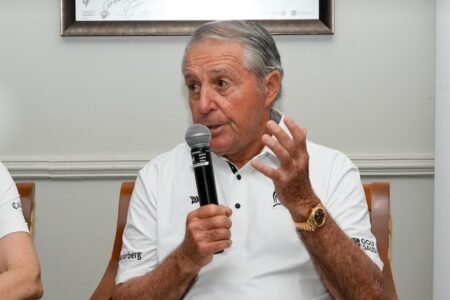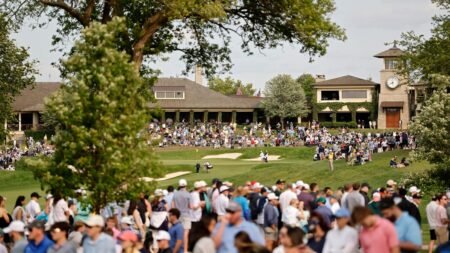Colt Knost, the former PGA Tour pro turned CBS Golf analyst and radio/podcast host, turned heads earlier this week when he revealed that, after 18 years as a professional golfer, he had applied to regain his amateur status from the United States Golf Association.
Two decades ago, Knost was an elite amateur; in 2007, he joined Bobby Jones and Jay Sigel as the only players to win three USGA titles in the same year. (In Knost’s case, those wins came at the U.S. Amateur Public Links, the U.S. Amateur and, as part of a team effort, the Walker Cup.) For five weeks that year, Knost held the top spot in the World Amateur Golf Ranking before making his first start as a professional at the Valero Texas Open.
Knost joined the PGA Tour in 2009 and went on to notch nine top-10 finishes in his career and more than $4 million in earnings. He played his last full-schedule season in 2015-16 and retired from competitive golf following a missed cut at the 2020 Waste Management Phoenix Open. Two years later, he joined CBS as a full-time analyst.
When Knost, who now is 40, announced his desire to regain his amateur status, he said his decision was partly motivated by wanting to qualify for the U.S. Mid-Amateur, but that no one should be under the illusion that his game still packs the punch that it did when he was in peak form. On Wednesday, on Knost’s Sirius XM show, Knost added that he also has dreams of one day captaining a U.S. Walker Cup team, and that being an amateur “would probably help” his chances. None of that rationale, however, is likely to assuage critics of Knost’s (or, for that matter, any other longtime pro’s) move back to amateurism, some of whom have been popping off on social media.
“Total bullsh-t,” John Ziegler, a two-time U.S. Mid-Amateur qualifier who hosts The Death of Journalism podcast, wrote on X. “You were a pga tour pro. Now, on a lark you want to take a coveted spot away in a USGA championship from an actual amateur. … You should know better and should be ashamed.”
Should he, though?
The rules permit changes of heart, and Knost is far from the first high-level pro to return to his amateur roots. Gary Nicklaus, Jack’s son, did it in 2007. Dillard Pruitt was another; after a decade-long PGA Tour run in the 1980s and 90s, Pruitt was granted reinstatement and promptly won the Sunnehanna Amateur and Canadian Amateur. John Peterson, a former pro who finished 4th at the 2013 U.S. Open, also has returned to paycheck-less golf. At this year’s U.S. Mid-Am, six of the eight quarterfinalists — including eventual winner Brandon Holtz — were former pros, indicating the top shelf of amateur golf is littered with players who once played for cash.
“We’re seeing more and more kids turn professional and give it a go,” Thomas Pagel, the USGA’s chief governance officer, said on Sirius XM PGA Tour Radio this week. “Therefore we’re seeing more and more applications coming back to us. Once you have success and once you get one of those cards, man, it’s really, really hard to keep it.”
According to the USGA, roughly 800 U.S.-based pros — including not only tour professionals but also the club and teaching variety — annually apply for reinstatement, and virtually all are approved. Which isn’t to say every candidate zooms back to the amateur ranks. Far from it. On Thursday, I spoke with Craig Winter, the USGA’s senior director, Rules of Golf and amateur status, to better understand how the process works.
How do pros apply for amateur reinstatement?
Pros who want their amateur status back need only answer a couple of dozen questions on an application available on the USGA’s website; the application fee is $200.
Among the information candidates must supply are the names of any tours on which they have competed, their results, cuts made and prize money won. The app also asks for “two people who can attest to the accuracy of the information provided.”
“The more somebody puts into an application, the less we have to do research ourselves,” Winter said. “And frankly, the less back and forth there is when the application matches what we see in public records. It’s a simpler process for us.”
Winter said the review process for a player of Knost’s pedigree is more rigorous.
“We’re trying to make sure that our decisions, especially with that type of a player, is as like as it can be to others,” he said. “And so we’re trying to get a full understanding of what the playing record was.”
Who makes up the applicant pool?
Applicants run the gamut from established tour pros to dreamers who never made it to teachers who ply their trade at clubs and driving ranges. Few applicants have had sustained success at a high level, Winter said, but those who have should expect a longer waiting period before they are granted reinstatement.
There’s no precise formula, because how could there be?
“We try to look at players that have that have had success and try to put them kind of in similar buckets,” Winter said. “Like being treated alike is probably the best way to put it.”
Tell us more about these waiting periods!
The minimum waiting period for a pro seeking reinstatement is six months from their last “professional action,” meaning, for example, a tournament start or a paid lesson. But for more decorated tour pros, the “cooling-off” period, as Winter phrased it, can take years.
“The more success you have, the more that you would be asked to wait from whenever your last breach was,” Winter said, referring to breaches of the rules of amateur status (i.e, competing as a pro, accepting a prize that is not permitted or holding a teaching job). “And the weight that we put on that is — it’s hard to just kind of put into words, specifically, but if you’ve played on a major tour and had membership, you’re going to wait quite a bit longer than someone who played mini-tour golf and won cash prizes or prizes above a thousand dollars, the limit in the current rules.
Phil Mickelson calls this golf-etiquette breach a ‘huge problem.’ Is it?
By:
Josh Sens
“We’ve had players that have waited eight years before, and that’s, again, from the date of the last breach. I think what often is a lightning rod for the public out there is when they hear somebody applied and they got reinstated right away. That kind of misses the facts of, well, when was the last time they breached the rules? And it may have been quite some time ago. I think in Colt’s case it’s been quite a while.”
It has, indeed — more than five years since his last start as a pro, meaning when the USGA rules on Knost’s reinstatement, he’s unlikely to have more than another year or two tacked on to his waiting period.
Has a pro ever been denied reinstatement?
No!
At least not as far as Winter can tell.
“We’ve done some looking and never seen anything to that effect in in our museum archives,” he said.
If everyone gets approved, why bother with the review process at all?
Take it away, Mr. Winter!
“Well, we want to have a process by which we can look, compare and ultimately have some system in place [by which], as I mentioned before, like situations are treated alike; we feel there’s value in that. The player coming off the PGA Tour and jumping right back into amateur golf, we don’t feel like that’s the right thing for the amateur game. So there is a waiting period that acts as a cooling off of sorts for players of that caliber, and it does help in in a way protect the amateurs that have been lifelong amateurs.
“And to say that we’ll let everybody in isn’t quite accurate. There would be a lot of players that could apply that would be told no. Those that are close to that edge, they are waiting a long time. Eight years is a long time to not be able to play an amateur golf competition after you ultimately hang up the professional golfing life.”
What would happen if, say, Scottie Scheffler, wanted his amateur status back?
Scheffler falls into what the USGA calls its “national prominence category” — in other words, players of repute. For pros in this class, the governing body’s decision is easy.
“I am very confident that Scottie, should he choose to apply or someone in his situation, he would receive a phone call that would say, ‘Scottie, unfortunately you do fit the national prominence category,’” Winter said. “‘And that means you’re not eligible to get your reinstatement back.’”
Finally..something most golfers can do that Scheffler can’t!
Read the full article here
